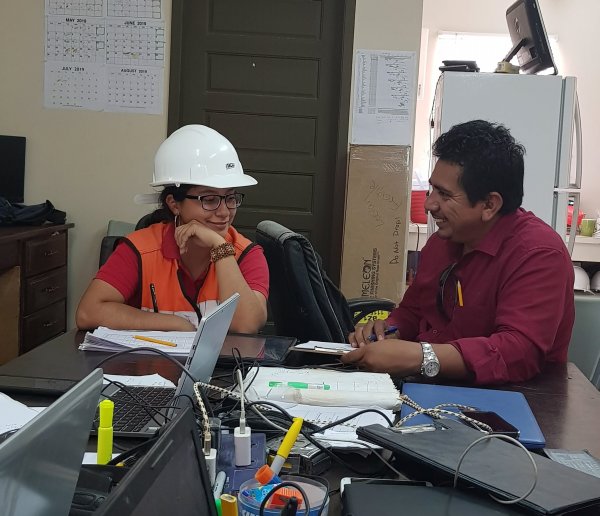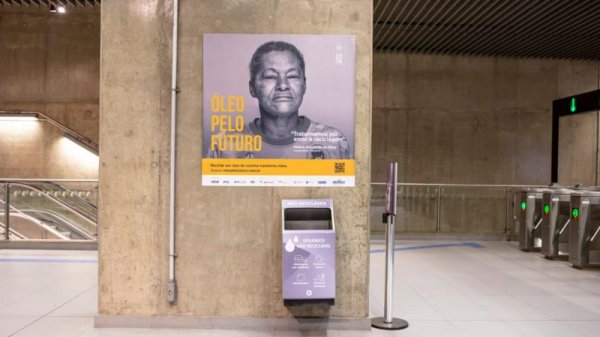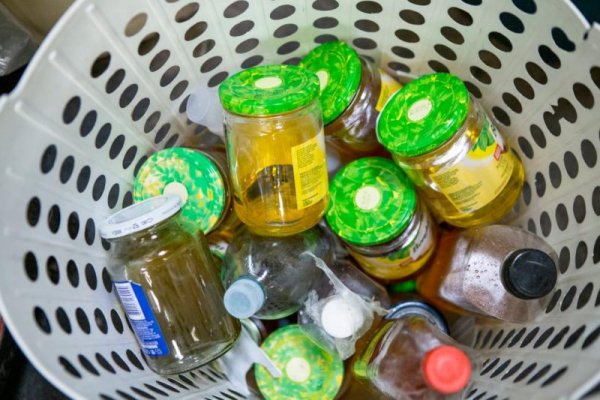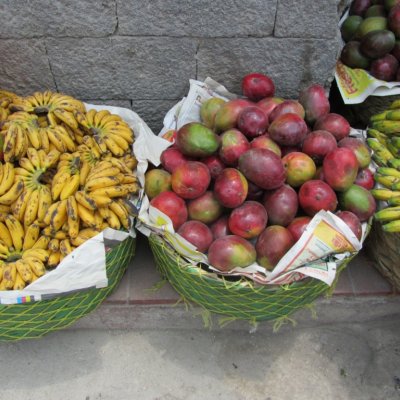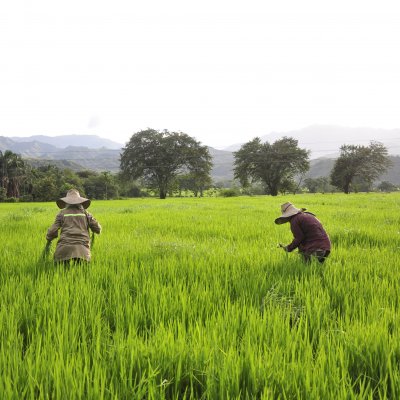Urban climate-resilience programs in Brazil and Belize changing behaviour of those threatened to be most impacted
This is the third article in a series introducing Proadapt, a regional initiative funded by IDB in partnership with NDF, to build climate resilience in micro, small and medium-sized enterprises in Latin America and the Caribbean. The article highlights two urban-centric climate resilience projects now underway: an initiative to drive cooking oil recycling in Brazil and an education and training program promoting resilient construction on the vulnerable coastline of Belize.
1. Cooking oil take-back program targets climate resilience while tackling water pollution in São Paulo
“It’s much easier to just dump cooking oil down the drain after frying than to collect it and take it to a recycling point,” says IDB Senior Operations Specialist Svante Persson. “So as with any recycling project, the question for Proadapt São Paulo was, how do we incentivise people to start changing their behaviour?”
The program, sponsored by NDF and IDB, and rolled out by executing agency, Cicla, took up this challenge with a widely successful program that is already bringing economic and environmental co-benefits to the city, not least by boosting a new circular economy that also promotes a more climate-resilient city water supply.
The program, which is now in its third year, began on the back of severe climate change problems, including droughts and flooding, in the state of São Paulo. This brought to light the negative consequences of improper handling and disposing of used cooking oil. This was oil that could be collected to sell forward and repurpose.
Building a business case
“In this scenario, a circular economy project that takes advantage of used oil as a raw material for social, economic and environmental transformation, has proved to be a win-win,” explains IDB Program Manager, Melissa Sendic. “But we knew it wouldn’t be enough to just appeal to people’s good will. For this to work, we needed real business modelling not just volunteering and do-gooding.”
The program began in 2017 with market research to assess the status quo. “We first needed to know who the current actors were, intermediaries, relevant industries and government agencies and what was their level of understanding and interest?” says Sendic. The next step was to begin establishing a network among them.
Need supply and demand
“To make a business viable you need to be able to create supply and demand,” Sendic explains. "Luckily the chain already existed for used cooking oil, which can be recycled and sold to the industry that produces biodiesel, a liquid fuel, for example for urban transport.”
So, with the demand already there, the team needed to figure out the supply side, and how they could get consumers involved as well as develop a methodology that could cover the cost of collection and recycling while driving up the value of the end product.
Social awareness campaigning
An ambitious social and transit media campaign that raised up real people as role models, was launched across the city with a view to educating the public on the positive case for recycling as well as stopping people from disposing of oil down their drains.
The name of the campaign, Oleo, was a big attention grabber. “The word ‘Oleo’ is a clever Portuguese word play, meaning oil, but the word is also a homophone for the Portuguese word to look forward,” Sendic explains.
The community-based campaign mobilised a huge network of private and public sector experts and stakeholders, including the Association of Brazilian Vegetable Oil Producing Industries (ABIOVE) and, importantly, the project was rolled out with the support of the Government of São Paulo city, including the departments of Transport, Sanitation and Water Treatment.
Government partnering a plus
Persson acknowledges the relationship with the Brazilian government as a landmark achievement, describing it as invaluable in scaling the public awareness part of the initiative and achieving such strong community support. And the numbers attest to this success, with an estimated 45 million people across 281 São Paulo municipalities reached by the initiative.
Of course, Sendic concedes that it’s not really viable for a householder to sell just a litre or two of used oil to a big cooperative so the goal is ultimately to explore and develop all kinds of locally-driven circular economies in partnership with local intermediaries. One example could be via local supermarket collection points, which would aggregate volumes of the used oil for sale to cooperatives. Consumers could then be rebated with discount groceries or oil could be exchanged for local services like hairdressing.
Higher volumes and better quality
“Ramping up volume to help the cooperatives gain critical mass for economies of scale has been one of the big wins of the program so far,” Sendic confirms. Previously biodiesel producers had only been sourcing from large houses or restaurant chains but tapping into small households has been a compelling proposition. Part of the project plan has also been to work with the industry to increase the quality of the take back oil to help drive up value. Added value comes from filtering and purifying the oil to generate better quality.
This attention to volume and quality has contributed to a more than doubling of the sell forward price for oil, which has gone from R$1,20 to R$2,50 reals per litre since the program outset.
2. Locally-driven training program targets climate-resilient infrastructure for Belize’s vulnerable coastline
As a low-lying coastal country, Belize is highly susceptible to the impacts of climate change and the intensifying natural disasters that come with it, notably hurricanes, high winds, flooding and heatwaves. Belize is ranked 8th out of 167 countries for climate risk, with temperatures rising faster than the global average.
Now, with approximately 40% of the population living and working along the coast, buildings are often constructed too close to the ocean, using cheap materials and unsustainable practices, and bringing large-scale infrastructure damage with every storm season.
“The flooding and storm surge get worse with every major storm,” reports Genesia Tucker, Project Coordinator with the Belize Chamber of Commerce and Industry. “Properties get destroyed, we rebuild and recover, then the next storm comes along.”
Need change now
According to Tucker, a gap has emerged between the urgent need to shift to more climate-change resilient infrastructure and the right support for the construction industry in terms of adopting new processes, materials and behaviours.
Working in partnership with IDB and NDF, the Belize Chamber has set out to address this gap with a new education and training program, Pro-Adapt Belize: Increasing Climate Change Resilience and Related Business Opportunities.
Focus on supply and demand
The project has been designed to work with the supply and demand side. That means decreasing the vulnerability of the construction sector by providing technical training, while also helping local product and service providers capitalise on the growing demand for relevant products and services.
On the supply side, resilience is a local business opportunity in the form of providing the much-needed products and services to mitigate and manage building exposure to high-risk weather. Simple examples of strategies might be raising the foundations to combat future flooding or sea-level rise; swapping nails for more expensive screws to batten down a roof against high winds; or using more heat-resistant building materials.
On the demand side, education and knowledge around climate-resilient infrastructure can be seen as a defensive strategy on the part of small companies looking for business continuity, including protecting their property, value chains and critical infrastructure or homeowners looking to protect themselves and their properties.
Building today for tomorrow
“But these decisions are often a case of short-term versus long-term thinking,” Tucker explains. “In Belize the prevailing social mentality is one of living in the moment, which basically means cutting corners and saving money wherever possible.”
It’s no surprise for example that the longer-term concept of sea-level rise in years to come is a hard sell for people in poverty, who are otherwise living day to day. “While investing in disaster preparedness pays off, it comes at a higher price,” explains Tucker, “and the tradeoff for some families could mean the difference between getting a new home or not getting one.”
Nevertheless, Tucker acknowledges that changing attitudes towards climate resilient construction will be vital in achieving the goals of this project and the way forward, including instilling a greater understanding of what climate change is and the reality of its impacts.
“This starts with service providers like architects, engineers, and contractors being able to pass on the significance and the benefits of investing more in climate resilient construction projects," Tucker asserts. “That means teaching people to build today with tomorrow in mind.”
Construction sector key but needs support
The construction sector, which spans many regions, industries, and economies can play a pivotal role in preparing Belize’s coastal communities to withstand the effects of extreme weather. “Construction people are in a position to influence behaviour but need to have knowledge and good practices themselves first,” says Tucker.
A skills demand assessment conducted by the Belize Chamber of Commerce at the outset of the program in 2019 to inform the curriculum development revealed that a vast majority of the stakeholders knew little or nothing about climate change and its growing impacts but that there was a big appetite to learn.
The survey also highlighted key gaps that can be addressed through a robust and specialized curriculum to build competencies among a target audience of construction workers, supervisors, project managers, engineers, architects and business owners.
The new curriculum is intentionally broad-based focusing on areas from Health and Safety, Quality management and social mentality to Climate resilience, mitigation and disaster risk.
Where is the program now?
With the curriculum development as well as a targeted awareness campaign now complete. The program team is at the stage of having conversations with the management of the local Institutes for Technical and Vocational Education and Training (TVET) colleges to see which schools would be equipped to facilitate the integration of the curriculum.
“The goal is to integrate the curriculum into a minimum of 3 TVET colleges, in order to start the pilot training,” Tucker confirms.
The program continues to receive widespread support, reflected in the Steering Committee, which has strong cross-sectoral representation and buy-in from the highest levels, including senior trade association officials, even the Director of the Belize Central building authority.
Public-sector role models
This project also comes at a time when the Belize national government is committing to a new state of the art coastal road that has climate resilience as a core requirement in materials selection.
Tucker has also learned from the Belize Ministry of Education that climate resilient infrastructure projects including new school buildings are ongoing. “Climate-resilient expertise in the design and construction of these schools is an absolute requirement,” Tucker stresses, “because they will also double as hurricane shelters for the community.”
In both the above projects, São Paulo and Belize, the big challenge has been managing the status quo while planning and preparing for a climate future that looks set to worsen. “Underscoring both these complex undertakings is one uniting success factor,” Persson concludes, “and that is an approach that seeks to change the behaviour of those who stand to be most affected.”
If you found this useful, you might like to know that the Proadapt facility has commissioned a Private Markets for Climate Resilience Study, which took a frontlines look at how the private sector in six developing countries is addressing climate risk in agriculture and transportation. Along with identifying a vast range of promising climate resilient business examples and solutions, the study also came up with findings and recommendations on how private stakeholders could become more active, as well as gain a better understanding of the business case for doing so.
More information:
Early-warning weather systems saving lives and expanding livelihoods
Pescadora climate resilience program finds plenty more fish in the sea

